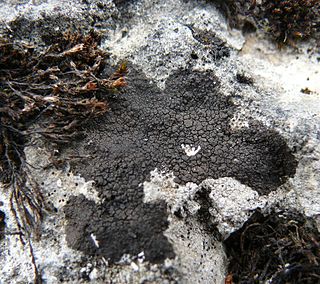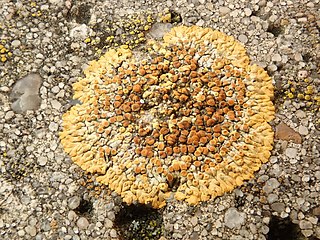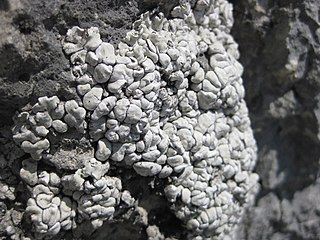
Verrucariaceae is a family of lichens and a few non-lichenised fungi in the order Verrucariales. The lichens have a wide variety of thallus forms, from crustose (crust-like) to foliose (bushy) and squamulose (scaly). Most of them grow on land, some in freshwater and a few in the sea. Many are free-living but there are some species that are parasites on other lichens, while one marine species always lives together with a leafy green alga.

Toninia is a genus of lichen-forming fungi in the family Ramalinaceae.

Bactrospora is a genus of lichen-forming fungi of uncertain familial placement in the order Arthoniales. It was circumscribed by Abramo Bartolommeo Massalongo in 1852.

Mazosia is a genus of lichen-forming fungi in the family Roccellaceae. The genus was circumscribed by Italian lichenologist Abramo Bartolommeo Massalongo in 1854.

Placidium is a genus of crustose to squamulose to almost foliose lichens. The genus is in the family Verrucariaceae. Most members grow on soil, but some grow on rock (saxicolous). The fruiting bodies are perithecia, flask-like structures immersed in the lichen body (thallus) with only the top opening visible, dotting the thallus. Lichen spot tests are all negative. Members of the genus lack rhizines, but otherwise resemble members of the genus Clavascidium.

Thyrea is a genus of lichen-forming fungi in the family Lichinaceae. It contains four species that have been accepted by Species Fungorum. The genus was circumscribed by Italian lichenologist Abramo Bartolommeo Massalongo in 1856, with Thyrea plectospora assigned as the type species.
Sagiolechia is a genus of lichen-forming fungi in the family Sagiolechiaceae. The genus was circumscribed by lichenologist Abramo Bartolommeo Massalongo in 1854, who assigned Sagiolechia protuberans as the type species. The family Sagiolechiaceae was proposed in 2010 to contain Sagiolechia as the type genus, and genus Rhexophiale; molecular phylogenetic analysis showed that these two genera formed a distinct clade in the Ostropales.

Haematomma is a genus of crustose lichens established by Abramo Bartolommeo Massalongo in 1852. It is the sole genus in the Haematommataceae, a family circumscribed by Josef Hafellner in 1984. Commonly called bloodstain lichens, the species assigned to this genus are widely distributed in tropical and temperate areas.

Xanthocarpia is a genus of mostly crustose lichens in the family Teloschistaceae. It has 12 species with a largely Northern Hemisphere distribution.

Solenopsora is a genus of lichen-forming fungi in the family Catillariaceae. It has 15 species, with a mostly Northern Hemisphere distribution.

Loxospora is a genus of lichen-forming fungi in the family Sarrameanaceae. It has 13 species. The genus was circumscribed by Italian lichenologist Abramo Bartolommeo Massalongo in 1852, with Loxospora elatina assigned as the type species. This crustose lichen was originally named Lecanora elatina by Erik Acharius in 1810.

Sporastatia is a genus of crustose lichens in the family Sporastatiaceae. It has four species. Sporastatia lichens are long-lived species that grow on siliceous or weakly calcareous rocks in arctic and alpine locales.

Pyrenodesmia is a genus of lichen-forming fungi in the family Teloschistaceae. The genus currently includes 23 recognized species but is believed to contain many more unnamed taxa. The genus was circumscribed in 1852 by Italian lichenologist Abramo Bartolommeo Massalongo. It is characterised by the complete absence of anthraquinones and the presence of Sedifolia-gray pigments in both the thallus and apothecia. These lichens are typically found in calcareous outcrops in the Northern Hemisphere, with biodiversity centres in the Mediterranean basin, Central Asia, and arid regions of western North America.

Calogaya pusilla is a species of saxicolous (rock-dwelling), crustose lichen in the family Teloschistaceae. It was originally formally described in 1852 by Italian lichenologist Abramo Bartolommeo Massalongo, who placed it in genus Physcia. The type specimen was collected in Veneto, Italy. It has undergone several changes of genus in its taxonomic history, including transfers to Caloplaca, Placodium, and Teloschistes. In 2013, it was placed in the newly circumscribed genus Calogaya.
Sporodictyon is a genus of crustose lichens in the family Verrucariaceae. It has 10 species. Most species grow on rocks, although some have been recorded overgrowing soil and mosses.
Phacopsis thallicola is a species of lichenicolous (lichen-dwelling) fungus in the family Parmeliaceae. It was first formally described as a new species in 1852 by Italian botanist Abramo Bartolommeo Massalongo, as Lecidea thallicola. The type specimen, collected from the province of Treviso in Italy, was growing on the foliose lichen Parmelia caperata. Dagmar Triebel and Gerhard Walter Rambold transferred the taxon to the genus Phacopsis in 1988. The known generic hosts of Phacopsis thallicola are all in the Parmeliaceae: Parmotrema, Cetrelia, Flavopunctelia, and Hypotrachyna.

Ochrolechia upsaliensis is a species of crustose lichen in the family Ochrolechiaceae. Found in the Northern Hemisphere, it is commonly known as the tundra saucer lichen.

Heteroplacidium compactum is a species of areolate, crustose lichen in the family Verrucariaceae. It has a cosmopolitan distribution. It is a lichenicolous lichen, growing as a facultative parasite on other lichens, typically on non-calcareous rock. It has rod-shaped (bacilliform) conidia measuring 5–7 μm long, and ascospores that are 11–18 by 8–10 μm. Heteroplacidium zamenhofianum is a closely related species distinguished by having perithecia situated in the algal layer, and smaller ascospores with a more narrow ellipsoid shape.

Piccolia is a small genus of crustose lichens in the class Lecanoromycetes. First circumscribed by Italian lichenologist Abramo Bartolommeo Massalongo in 1864, it contains ten species. Due to a lack of molecular data, it has not been assigned to an order or family.

Thalloidima is a genus of lichen-forming fungi in the family Ramalinaceae. It has 13 species.

















